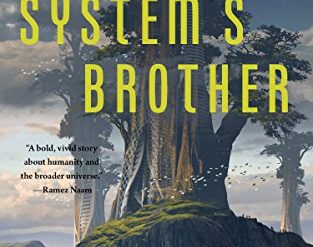
Estimated reading time: 6 minutes
The city-state of Philadelphia. Late twenty-second century, more than a hundred years after the Conflict. The federal government has little clout now, and the United States of America is no more. The city’s poor crowd the Combs, an overpopulated slum in the immense crater carved out by a Chinese thermonuclear weapon. The rich—superrich, really, by contrast—live in opulent mansions on the Rim. The Combs seethe with discontent. But a five-member Business Council and platoons of mercenaries (“mercs”) maintain order, protecting the Rimmers. This is the setting for David Walton’s award-winning thriller about breakthroughs in brain science, Terminal Mind.
Biological modifications offer unlimited possibilities
Young Mark McGovern is the son of the wealthy chairman of the Business Council, perhaps Philadelphia’s most powerful citizen. As the novel opens, he and his sister Carolina, are attending a party of the city’s richest and most fashionable people at their father’s behest—and he’s hating it. All around him the city’s elite parade in their “mods,” or biological modifications, made possible by highly evolved genetic engineering.
A few have extra limbs, such as a surgeon with two thumbs on each hand. Others, well past one hundred years of age, look fifty or even younger. They all sport Visors, sensors implanted into their brains with ports on their foreheads that allow them to connect with the worldwide optical network and to communicate telepathically. They’re all beautiful physical specimens. And all are unbearably colorful, with brightly hued hair or beards that blink and shimmer like rainbows, complementing their designer attire. Yet far more consequential are the breakthroughs in brain science that permit experiments in downloading consciousness and power this fast-paced novel.
Terminal Mind by David Walton (2008) 316 pages ★★★★☆
Winner of the Philip K. Dick Award

A youthful prank goes horribly wrong
For Mark, the party is a nightmare. His best friend, Darin Kinsley, is a Comber. The two young men reject the pretensions of Rimmer society and are more apt to be out on the town seeking small ways to rebel. And this night, once he manages to free himself from the party, Mark joins Darin and their friend Praveen Kumar in a prank. They’re “crackers,” well-intentioned hackers out for a bit of fun—a “crackerjack.” They send a stream of code speeding toward a satellite overhead, connecting at random with an unknown recipient at the Navy base in Norfolk, Virginia . . . and all hell breaks loose.
By some diabolical coincidence, the young men have chosen precisely the wrong person to target in their prank. She is Marie Coleson, a young widow who works in the Navy’s anti-viral lab, where she battles the most vicious and damaging forms of malware that plague the world of the late twenty-second century. And the most alarming of the endless varieties of malicious code is a “slicer,” volatile software “generated from a human mind. It’s just as complex and flexible and, well, intelligent as the original.” By ever so briefly opening up a channel from Marie’s lab to the satellite, the prank has released a slicer she had imprisoned. It’s the mind of a four-year-old. And he or she is under the control of a sociopathic physician bent on seizing control of the city.
Assessing this novel
If you’re a science fiction fan and you read this book quickly without thinking about it too deeply, you’re likely to enjoy it. Walton’s dystopian future America is clever and well-developed. The action is fast-paced, the plot ingenious, and the principal characters likable—except for Dr. Alastair Tremayne, a comic-book version of a villain. And if you make the mistake of pondering the characters’ motivations and the coincidences that lie at the heart of the story, you may be disappointed. Terminal Mind is a good read, but it doesn’t end up high on the plausibility scale.
About the author

Here’s what David Walton writes about himself on his author website: “I live near Philadelphia with my wife and seven children. I enjoy playing jazz and musical numbers on the piano, long walks with my family, and playing Chess and Go. I work as an engineer for Lockheed Martin. I’m a member of Tenth Presbyterian Church.
“I love reading and writing science fiction. Science fiction is a genre where the big ideas of life, what it means to be human, what our future will be like, and how things could be different than they are, can be explored from every possible angle. I’m continually astonished and thrilled that get to be a part of this dialog, writing stories that contribute, in a small way, to the canon of ideas that great writers before me have built, and continue to build.
“I am a Christian. Unfortunately, these days Christianity gets associated with certain political views, most of which I do not hold. As a Christian, I am for the oppressed, the downtrodden, the helpless, the poor, the immigrant, and the refugee. I am for all voices being heard, and all lives being valued. I believe we gain knowledge and wisdom by listening to those who are different than we are and learning to understand what life is like from the perspective of those most unlike ourselves.”
For related reading
I’ve also reviewed three other terrific science fiction novels by David Walton:
- Living Memory (These dinosaurs left something behind)
- Deadly Memory (Paleontologists unearth a deadly weapon—and a killer virus)
- Memory Reborn (Dinosaurs live (and I don’t mean just birds)!)
- The Genius Plague (The greatest threat to humanity is . . . a mushroom?)
David Walton is one of 10 new science fiction authors worth reading now.
For more good reading, check out:
- The top 10 dystopian novels
- These novels won both Hugo and Nebula Awards
- The ultimate guide to the all-time best science fiction novels
- 10 top science fiction novels
And you can always find my most popular reviews, and the most recent ones, on the Home Page.

























